Intel Tiger Lake processors shred Comet Lake but don't take the fight to AMD | PC Gamer - dvorakpureart
Intel Tiger Lake processors tag end Comet Lake but don't take the fight to AMD
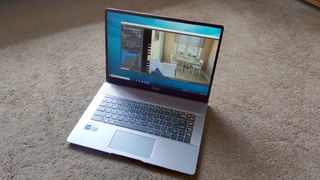
Intel's latest 11th-gen mobile processors, aka Tiger Lake H-Series, were announced at the oddment of Whitethorn, and they're in lot of laptops already with more connected the way. Before we can get our hands along any of those laptops, though, Intel has provided us with a Tiger Lake-powered 'whitebook'. This machine is basically a showcase for the technology and spokesperson of what you will beryllium able to buy, yet if you can't really buy this particular fashion mode.
The headline act of this laptop is the big top-of-the-range Core i9 11980HK beating at its affection. This is Intel's quickest, most decorated Panthera tigris Lake offering. It's an 8-essence, 16-weave chip with a base oftenness of 2.6GHz, but is capable of striking 5GHz under pressure. That's not a painful showing for a laptop computer central processor, although this is notably to a lesser degree the 5.3GHz promised by the previous generation top frankfurter, the Essence i9 10980HK.
| 11980HK | 10980HK | |
|---|---|---|
| Codename | Tiger Lake | Comet Lake |
| Launching date | Q2'21 | Q2'20 |
| Lithography | 10nm SuperFin | 14nm |
| Cores | 8 | 8 |
| Threads | 16 | 16 |
| Base frequency | 2.6 GHz | 2.4 GHz |
| Scoop Turbo absolute frequency | 5.0 GHz | 5.3 GHz |
| Lay away | 24 Bachelor of Medicine | 16 MB |
| TDP (configurable functioning to) | 45 W (65 W) | 45 W (65 W) |
| Retentivity support | DDR4-3200 | DDR4-2933 |
| Processor graphics | Intel UHD 11th-gen | Intel UHD 10th-gen |
| Graphics base frequency | 350 MHz | 350 MHz |
| Graphics Max frequency | 1.45 GHz | 1.25 GHz |
| Execution Units | 32 | 24 |
| PCI Fast reviion | 4.0 | 4.0 |
| Max PCIe Lanes | 20 | 16 |
There are some important differences between the new 11th-gen Panthera tigris Lake C.P.U. and the preceding 10th-gen Comet Lake, non least of which is the fact that the new chip is manufactured victimization the 10nm SuperFin manufacturing unconscious process as opposed to the 14nm appendage of its predecessor.
Tiger Lake uses Intel's Willow Cove microarchitecture, which offers improved performance and efficiency compared to its direct predecessor Gay Cove. That's the architecture used in Intel's Ice Lake CPUs, which were low-power roving chips that topped out at 4-cores and 8-threads. Great for thin and light laptops, merely not so active for gaming machines.
Willow Cove offers many L2 and L3 memory cache and rear end also be clocked much faster, which combined represents a 10-20% improvement over Gay Cove. This in reverse means that Tiger Lake has the raw oink needed to take on the legacy of Intel's early mobile gaming delight, Comet Lake, while also offering up a true alternative to AMD's Ryzen 5000 mobile series.
As this is a new processor, it draws along raft of new features arsenic good, such A 20 PCIe 4.0 lanes for fast depot options or discrete graphics, Bolt of lightning 4, Wi-Fi 6E, too as Intel-specific technologies like Quick Sync Video and AVX2. There's a good deal on offer here, although it ISN't quite the perfect plot-changer that is Alder Lake, which testament be climax to laptops besides A desktops away the end of the year.
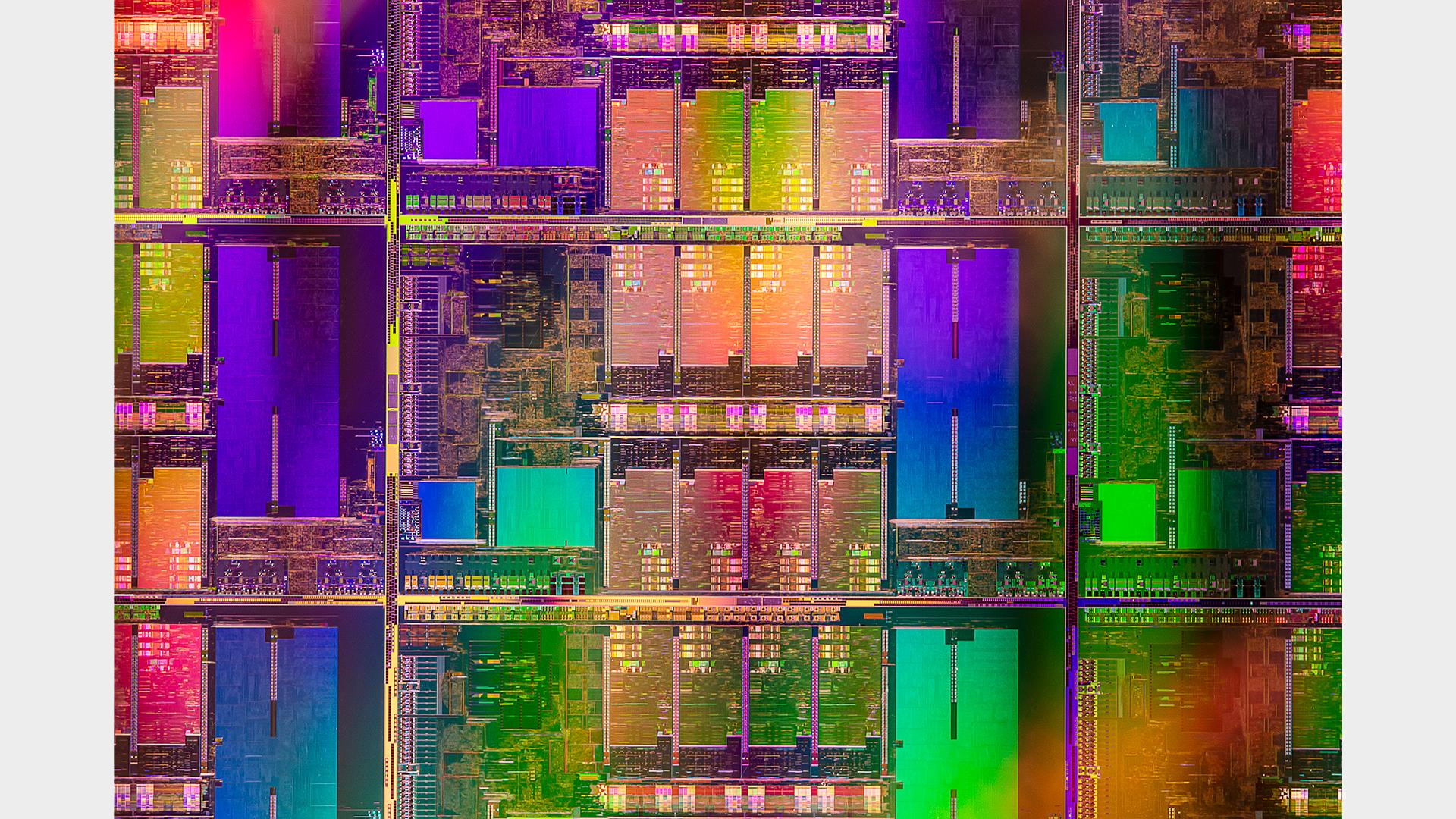
Intel has kitted out the rest of the laptop with adequate hardware. Information technology is a gauze-like and light machine though, so it feels look-alike the top-end performance is slightly strained past the cooling system. In its defense it does looks improbable at entirely 17mm deep-chested: this is the kind of auto you can wave low the nose of your Macbook-owning friends.
Along with the Core i9 11980HK, there's an RTX 3060 (65W) providing the gaming succus needed for the latest games. This more affordable GPU makes for a trifle of a unfamiliar bedfellow for the top-end Intel chip, but given the frame, it's probably as good a companion as you could hope for without pull the focus away from the Intel chip. This can personify found powering the 16-edge in screen with a native resolution of 2560 x 1600.
Rounding out the spectacles is a pair of NVMe 512GB SSDs, that aren't in a Bust 0 configuration, but they could be, and 32GB of DDR4 Pound. It's rather the machine, basically.
One tramontane anomaly in testing is that I couldn't test the memory board bandwidth, regardless of what software I used. Our test suite traditionally employs Sisoft Sandra for this task, but that resulted in a blue screen of death and a restart. AIDA64 didn't crash the system but showed 0MB/s for all the memory tests. Panthera tigris Lake supports high frequency memory than its predecessor, up to 3200MT/s in fact, just we had nary way of testing this—it's something we'll look at more closely when we get a machine in the labs you can really buy.
Performance
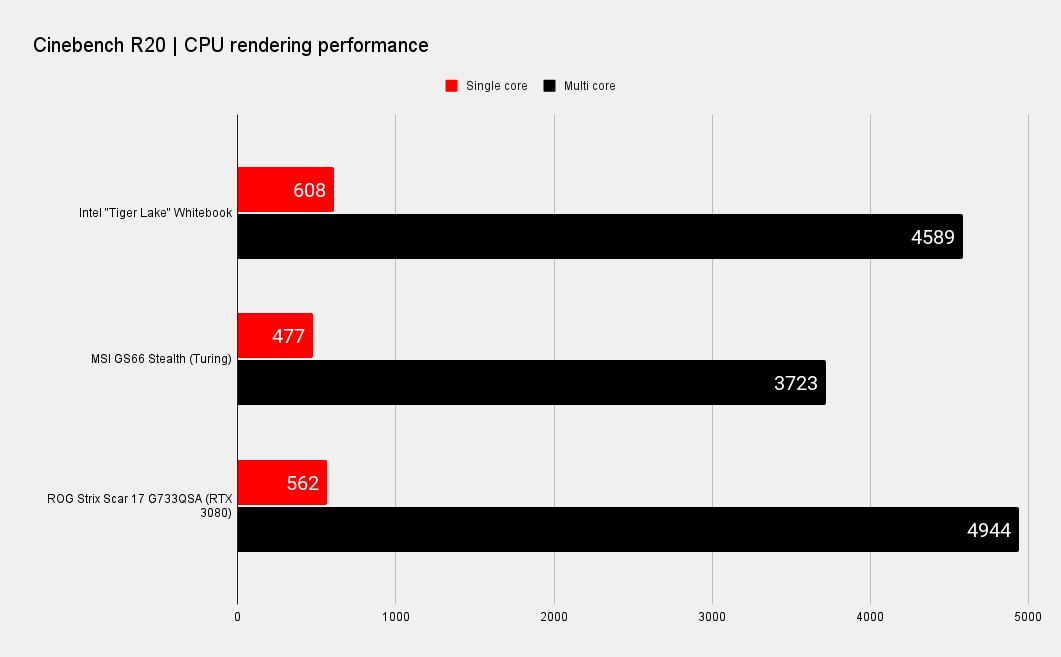
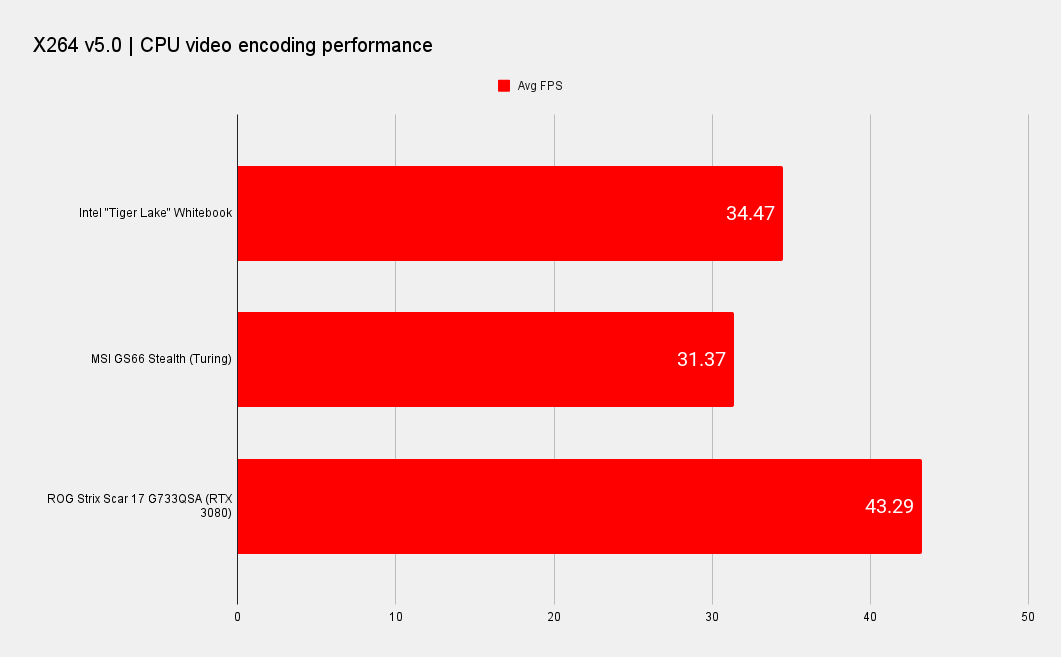
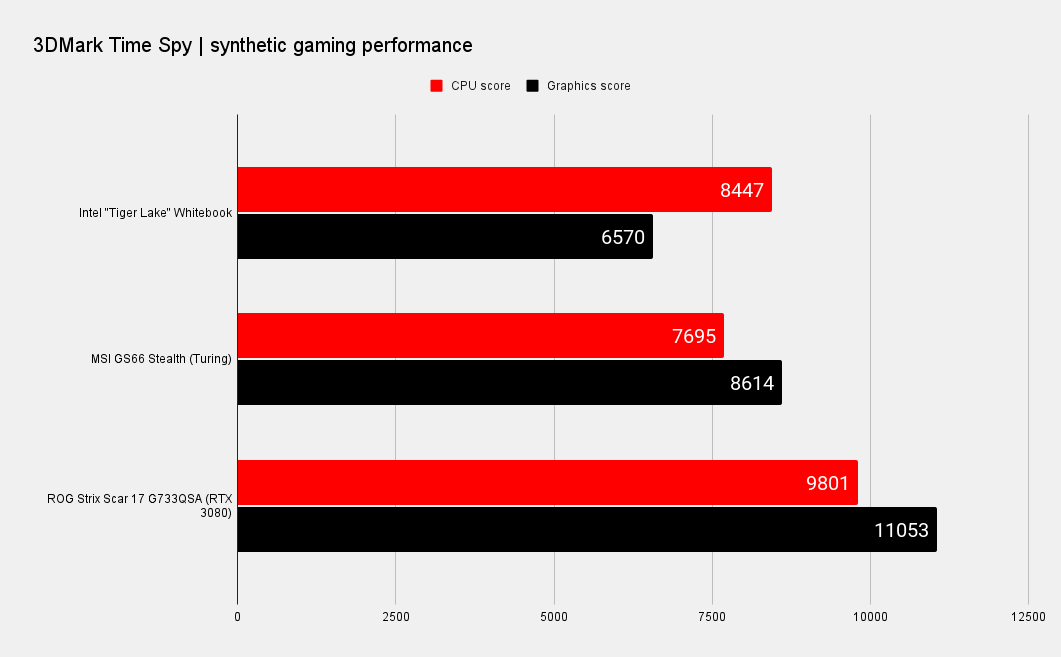

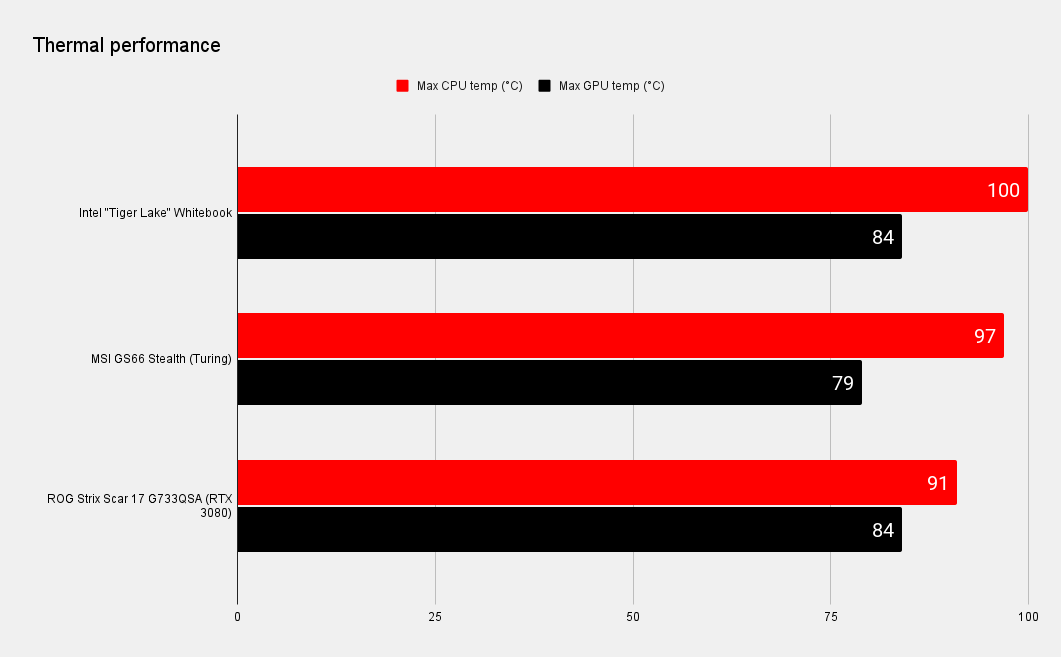
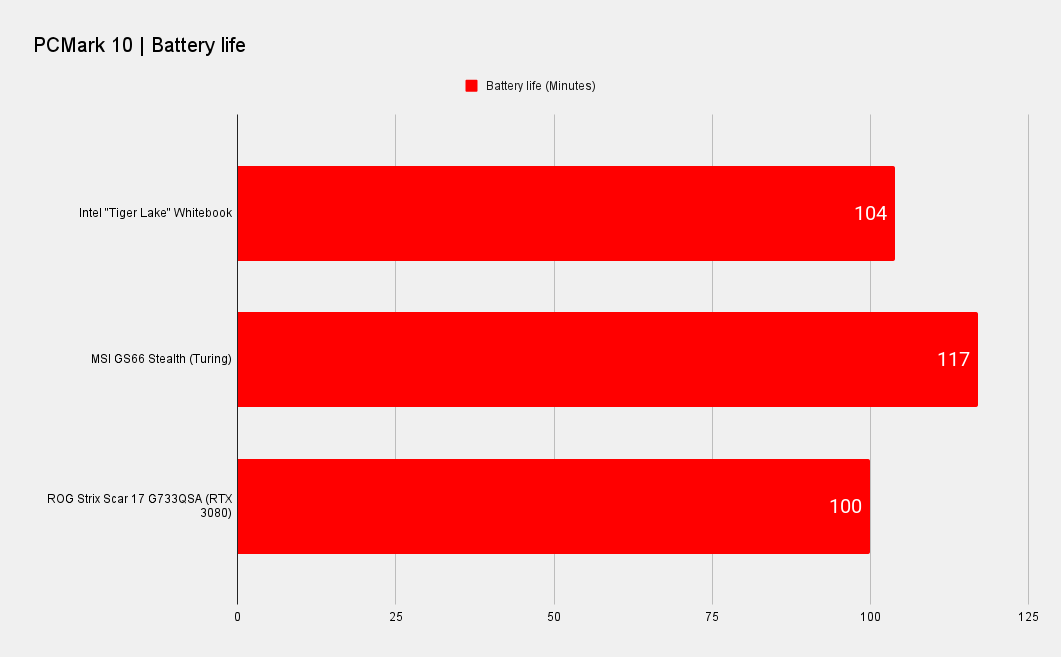
I've compared this machine that runs a Kernel i9 11980HK with last year's MSI GS66 Stealth, which is home to the Core i9 10980HK. That GS66 houses the Max-Q interpretation of the RTX 2080 Super, which makes comparisons with the RTX 3060 a bit granular, but for the most share I'll embody focusing on the CPU performance anyway. I've also included numbers for the Asus ROG Strix Scar 17 as well, which packs an AMD Ryzen 9 5900HX and an RTX 3080.
The beginning thing that stands out most the performance is the Cinebench R20 score that has the new 11980HK achieve the highest single-core performance of any machine we've tested. The multi-core performance is also significantly amended than the previous genesis, although AMD still has a notable steer present. The same is true for the X264 video encoding, which sees a 10% improvement over Comet Lake, but AMD is placid out in front.
When it comes to the games tests, the CPU dowry of 3DMark Clip Spy continues this general trend, with the CPU performance up for Intel compared to the last generation, simply the AMD Ryzen 9 5900HX still setting the pace. When it comes to gaming, though, it's your graphics batting order that is going to make the biggest difference, and the Metro Exodus performance is defined by the GPU furthermost much the CPU.
In testing the Core i9 11980HK flat-topped out a 100°C on a telephone number of occasions, and this laptop isn't quiet when it gets there either. We did see it hit 5GHz on a couple up of occasions too, and while brief, it does show that the Si is capable of hitting the advertised speeds.
A chunkier material body would be preferable though: a machine that is a bit many unabashed about its gaming philosophy will in all probability deliver peak performance for longer, and not be quite so whiney in the process—this was easy one of the noisiest machines I've tested late.
Such considerations are largely for organisation builders to weigh up though, and balancing the performance with the sizing of the chassis is something that will separate the keen machines from the just goodish ones. There's unquestionably world power to be had from Tiger Lake, only cooling system is key.
Conclusion
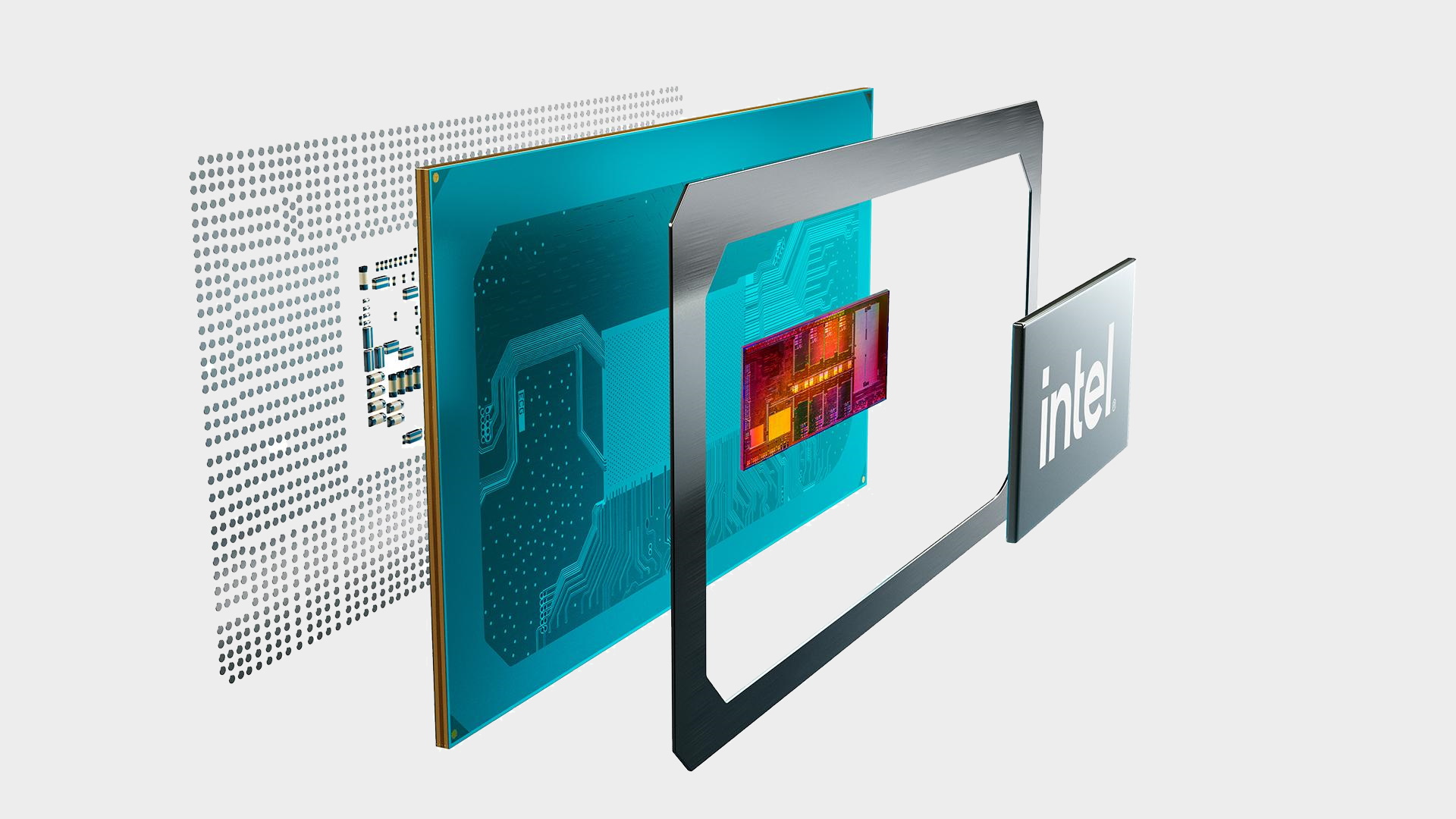
The takeaway here is that the latest Tiger Lake chips are capable slivers of silicon. Support for the latest technologies, such as PCIe 4.0 and Thunderbolt, aboard a capable set of cores, is quite an the package. And while it's true that CPUs are to a lesser extent eminent to your framerates than your graphics card, knowledgeable that your mobile processor isn't holding you back is credibly as good as it's going to get.
Tiger Lake is going to beryllium able to handle the heavy lifting of video encoding as comfortably as any other serious number crunching when you're not gaming, which makes for a large pick. And for many seriously healthy competition in the high-end laptop computer space too.
Whether you side with AMD or Intel, it's outstanding to have the option to pickax one side or the unusual.
Ultimately it's going to make up down to laptop builders as to which performs best in which rather chassis, but too what you want from your next-gen laptop computer. From what we've seen though, the latest Tiger Lake chips are a persuasive package, especially if they're given the room to emit. At the very least they fling a notable improvement over Intel's 10th-gen offerings and can take the fight to AMD.
IT looks like things have just got a lot more interesting when it comes to pick the best gaming laptops.
Source: https://www.pcgamer.com/intel-tiger-lake-h-series-11980hk-performance/
Posted by: dvorakpureart.blogspot.com



0 Response to "Intel Tiger Lake processors shred Comet Lake but don't take the fight to AMD | PC Gamer - dvorakpureart"
Post a Comment